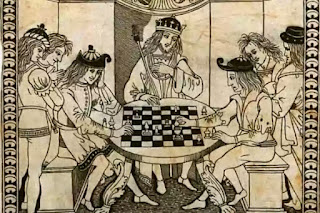History of chess.
Chess what we know today had a different name earlier that is chaturanga( which means 4 parts) which was indian sanskrit language word .Chess was said to be originated from India and then moved on Persia (Iran) . Chaturanga was earlier used to be of four player and slowly became 2 player game know as chess today . Earlier chess was having different sets of pieces altogether but aligned in the same manner as today .
Image source -Google | Image by -
An antique chaturanga and board pieces
The main objective has remained the same which is to checkmate ans had a different piece firzan(counselor), this piece was added after the resemblance of the word chaturanga and named as Shatranj.
Earlier there were four divisions (of the military)": infantry, cavalry, elephantry, and chariotry ,which were modern into pieces such as pawn , bishop ,knight , king , queen . Then onwards Persia was introduced to this indian chaturanga they named king "Shāh!" ( King in Persian language) and checkmate named as Shāh Māt!".
The Mongols call the game shatar, and in Ethiopia it is called senterej, both evidently derived from Shatranj
. The game was developed extensively in Europe. By the late 15th century, it had survived a series of prohibitions and Christian church sanctions to almost take the shape of the modern game. Modern chess was a con- sequence of many variations of chaturanga and made a game of intellectuals what we know today that is why it is called as game of intellectuals .
There is a slight change in the set of rules as compared to earlier chess .
Pawn promotion was uncertain into which piece it would get promoted ,this confusion was changed because earlier it was also the promotion of white coloured pawn into black piece and vice versa.
In the earlier chess board the queen was the weakest piece on the board. The bishop was also a short-range piece. Because the queen and bishop were so weak, the game was much slower than it is today. It took a long time for a player to develop the pieces and even longer to checkmate the enemy king. Indian development of the chess board can be concluded as true because of india's invention of number zero .
I think now you visitors might be clear on this part .
Thank you!
P.S.:- Comment down below if you want me to make a detailed blog on this topic and you can check my
first blog as well .


Comments
Post a Comment
Please do not enter any spam link in the comment box